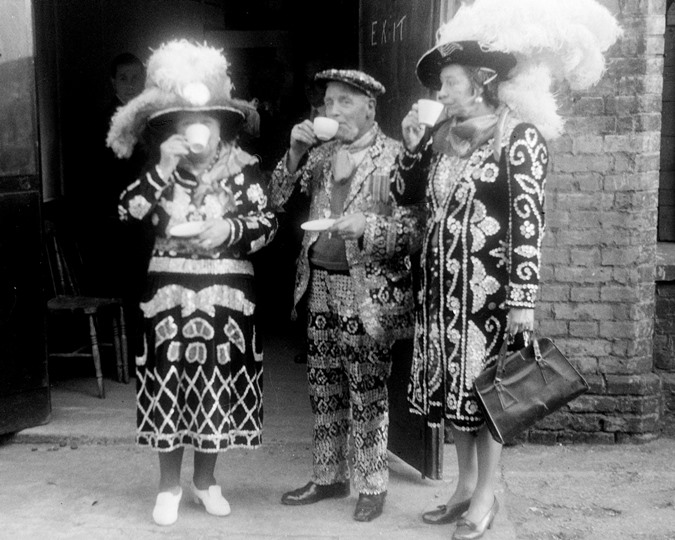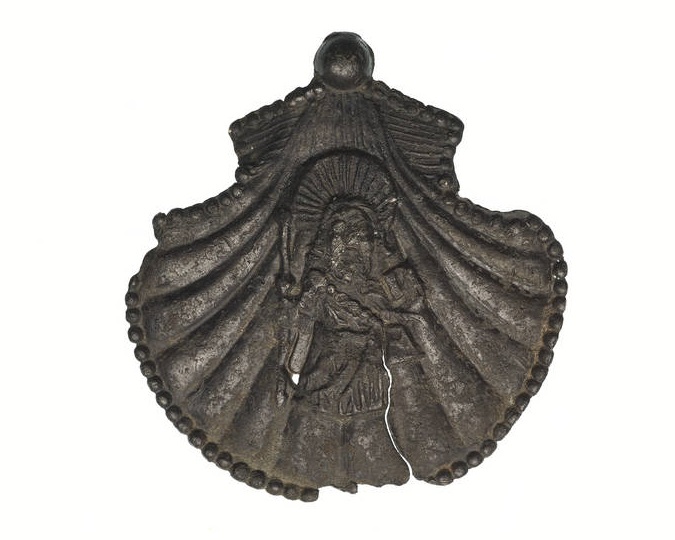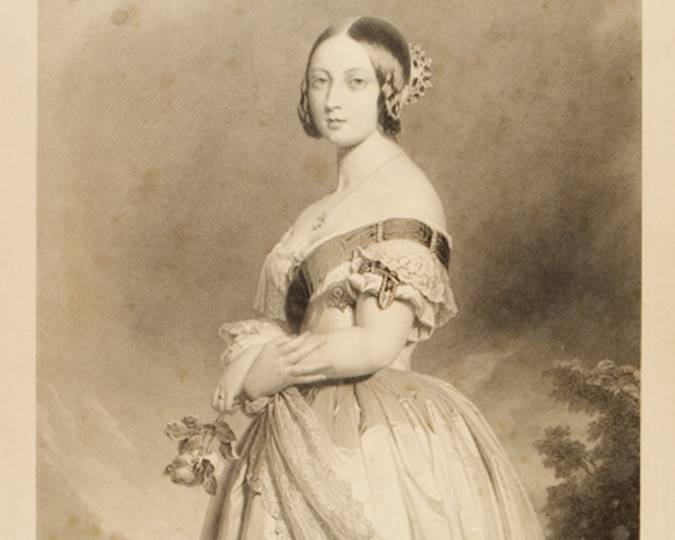Women's winter fashion once featured a curious and old-fashioned cylindrical handwarmer: the muff. Fashion curator Beatrice Behlen examines the history and design of these odd accessories, as represented in the museum's collection.
There are not many garments or accessories I wish would make a comeback. I am glad I do not have to totter about in hobble skirts, swim in woollen bathing suits or sport spats – well, the latter could be useful occasionally. But maybe we should orchestrate a return of the muff – no sniggering at the back!

Hills & Saunders; Royal Collections Trust.
For our 2017 winter display Keeping Warm, we gathered now-forgotten objects formerly used by Londoners to ward off the cold. This includes one of two fur muffs which belonged to Queen Victoria’s daughter, Princess Louise (1848-1939), supplied by W.C. Williams of 102 Regent Street. I am wondering whether Louise bought the muffs in anticipation of her move to Canada, when her husband John Campbell, Marquess of Lorne (later Duke of Argyll) became Governor General of Canada in 1878. The Princess was definitely photographed wearing warm clothes, albeit in front of a studio winter landscape complete with - presumably fake - snow.
The fur handwarmer from the Canadian photo is somewhat larger than our muffs, which are more similar in size to the one in this photo, taken more than ten years earlier. (One gets the impression that it was inconceivable for women to be photographed without them holding – or holding onto – something.)
I am quite intrigued by this accessory. We have quite a few muffs in the collection, mostly of the fur or feather variety, sadly not yet photographed. So I have selected some of my favourite pictures of muffs from the museum collection. They do not make up a complete muff chronology; for an excellent account of the early history, and the somewhat obscure origins of the term, see costume historian Pat Poppy.

Maybe the idea for the muff arose with the abandonment of the very wide, long, often fur-lined sleeves worn in the early half of the 16th century (think Holbein’s Anne of Cleves or paintings of other women of the Tudor court). You can still see the sleeves here in a 1577 print showing women of Cologne.
The earliest depiction of a muff we hold is a woodcut from Cesare Vecellio’s De Gli Habiti Antichi, Et Moderni di Diuerse Parti del Mondo (or Of the clothing, ancient and modern, of various parts of the world), first published in 1590. The Venetian lady carries a muff that seems to have been made of the same fabric as her gown, embroidered with pearls echoing her necklace.
The most prolific depicter of muffs was the Czech engraver Wenceslaus Hollar who came to England in 1637 and thereafter published several works with engravings recording the clothing of women in different parts of the world. Quite a few depict women with their by then quite large muffs, seemingly exclusively made of fur.
Originally a garment carried by women, the muff soon seems to have been taken on by men, not least by Samuel Pepys, always an early adopter. On Sunday 30 November 1662, Pepys noted the ‘bitter cold’ and decided to help himself to one of his wife’s accessories to keep warm on his travels through the capital between his home, the French church, a friend’s house and his office. He reported: ‘This day I first did wear a muffe, being my wife’s last year’s muffe, and now I have bought her a new one, this serves me very well.’
Muffs continued to be worn by both sexes throughout the 18th century. Carried by men, they were often taken as indicators of effeminacy, frequently seen as a result of imitating the dreaded French!
Mr Jessamy, a character in Isaac Bickerstaffe’s libretto for the comic opera Lionel and Clarissa (1768) is a case in point. Jessamy, the son of Colonel Oldboy (oh yes!) was brought up – and adopted the name and airs of – his maternal uncle Lord Jessamy. Now in his early 20s, he ‘mixes all his wine with water’, according to the colonel a sure sign of weakness whereas aged 16 Oldboy ‘could drink his pint of port or his bottle of claret’.
Jessamy’s room ‘is like a perfumer’s shop, with wash balls [soap], paste and pomatum [scented hair ointment]’. Sensing his father’s distaste, Jessamy asks what the problem is, which leads to the colonel bursting into song, listing what he hates and detests ‘of all things’: ‘A coxcomb, a fop, / A dainty milk-sop; / Who, essenc'd and dizen'd [decked out in fine clothes] from bottom to top, / Looks just like a doll for a milliner's shop. / A thing full of prate, / And pride and conceit; / All fashion, no weight; / Who shrugs and takes snuff, / And carries a muff; / A minikin, Finiking, / French powder-puff: / And now Sir, I fancy, I've told enough.’
Colonel Oldboy would not have liked the ‘amant transi’ or ‘bashful lover’ depicted in this 1735 print, but might have agreed with the slightly saucy inscription. The boy pictured is told to give up his 'sleeve': "Believe me, to better brave a cruel season / Go, run to the bosom of your belle to warm yourself."
Judging from the many caricatures featuring muffs produced during the 1780s, that decade must have seen one of the major peaks in muff size. It seems that towards the end of the 18th century, muffs were again primarily confined to women. During the 1790s particularly splendid examples can be found in Heideloff’s Gallery of Fashion. In the early 19th century the journal Ackerman’s Repository of Arts features muffs extensively, the ermine (or mock ermine) variety apparently a favourite.

Gertie Millar photographed as "Dancing Mistress", 1912
Gertie Millar played Nancy Joyce, the dancing mistress of the Brighton school 'Down House' who is dismissed but finds fortune and happiness in Switzerland.
From the 1830s until the First World War, the size, but not the popularity of the muff is diminished. Larger examples can again be found in the second decade of the 20th century, such as the muff that forms part of Gertie Millar’s costume for her role as Nancy Joyce in the ‘Dancing Mistress’, in which she finds fortune and happiness in Switzerland.

Image of a woman modelling a coat for Debenhams, 1935
Published in Illustrated Sporting & Dramatic News.

I get the impression that between the wars, muffs become even more of a luxury item than they were before. One appears in a beautiful lithograph from the mid-1930s by the French illustrator Etienne Drian for the couturier Molyneux. In 1935, Debenhams offered a coat with matching hat and muff, sadly probably made of real leopard fur.
The most recent incident of a muff I could find in our collection forms part of one of five plastic outfits made for a 1950s doll. Her short, blue day coat with red collar, cuffs, belt and hem seems to incorporate a matching fur muff. While I have very vague memories of muffs being hung around children’s necks with cords in the 1960s, I presume its eventual demise correlates with the disappearance of hats during that decade (without bouffant hair being one of the issues). There is something old-fashioned about muffs, they just don’t seem to fit modern life.
Muffs, particular the smaller ones, demand a stance that suggests demureness, which is at odds with the jumping dollies of the 1960s and the striding amazons of the 1970s. Even during the fur-loving 1980s muffs only make a rare appearance. If they do, they are of the large variety, massive objects of conspicuous consumption.
So, what about a comeback? I now think maybe not. While I always like the idea of striking a pose, and a muff, particularly a big one, is good for that, it probably would not fit in particularly well with my day-to-day life. I am also uneasy about its long association with fur. I will focus on enjoying images of the many fabulous muffs produced in the past.
Love fashion? Subscribe to our free fashion newsletter to read more stories from our collections, and see upcoming events and exhibitions.
















